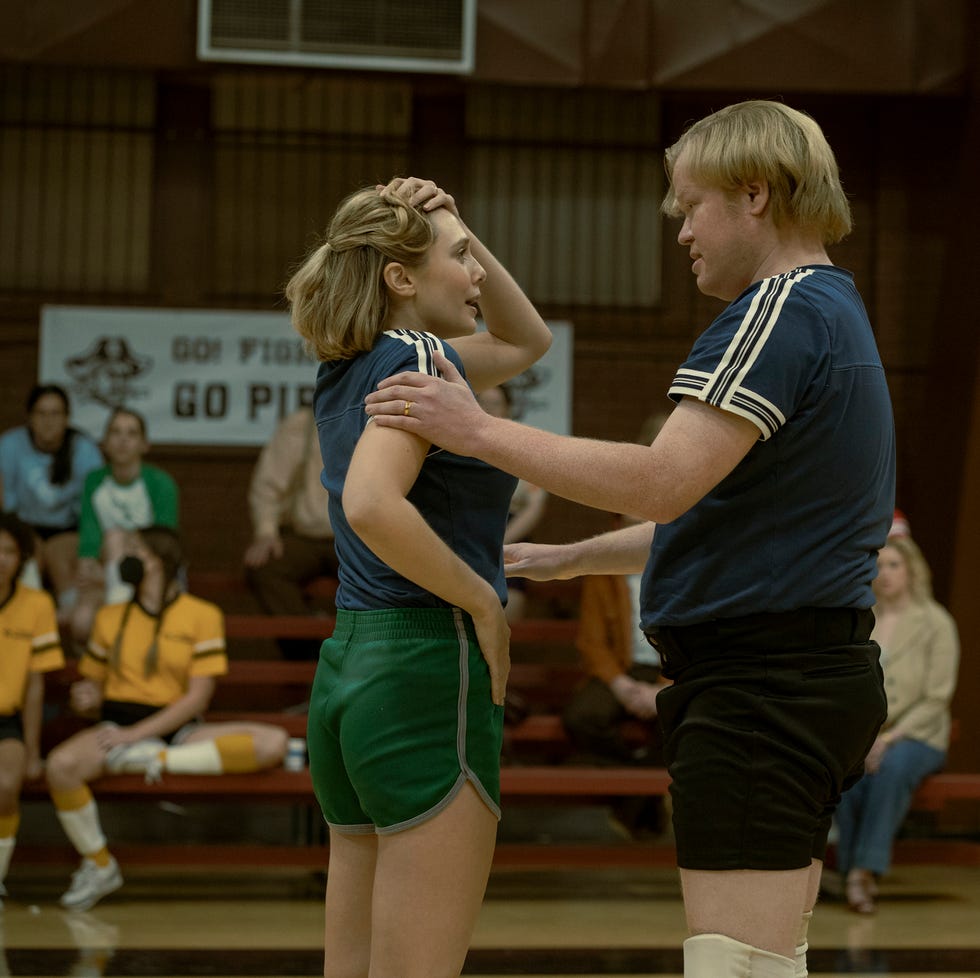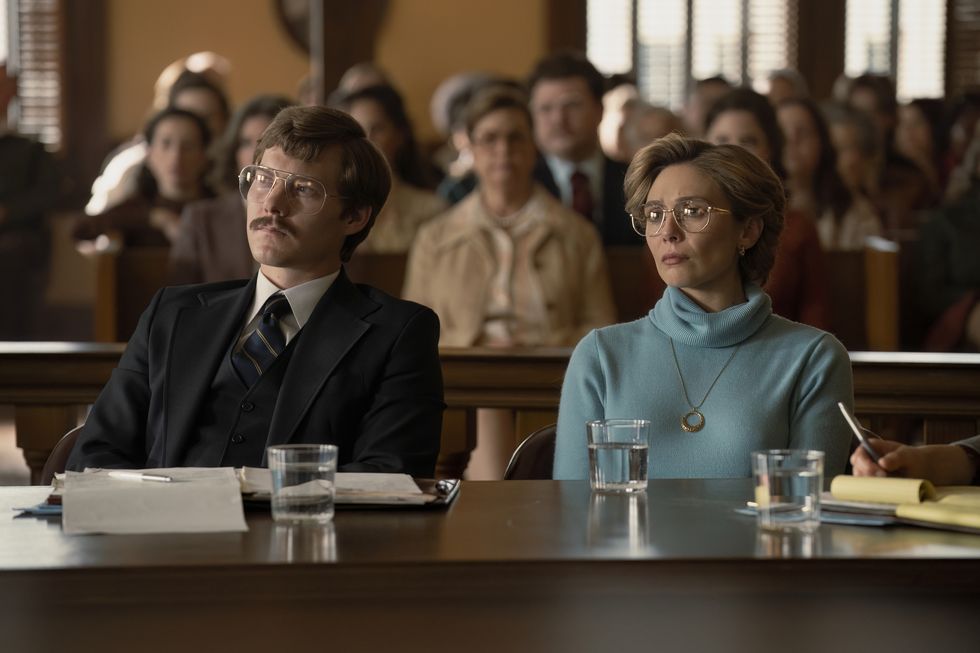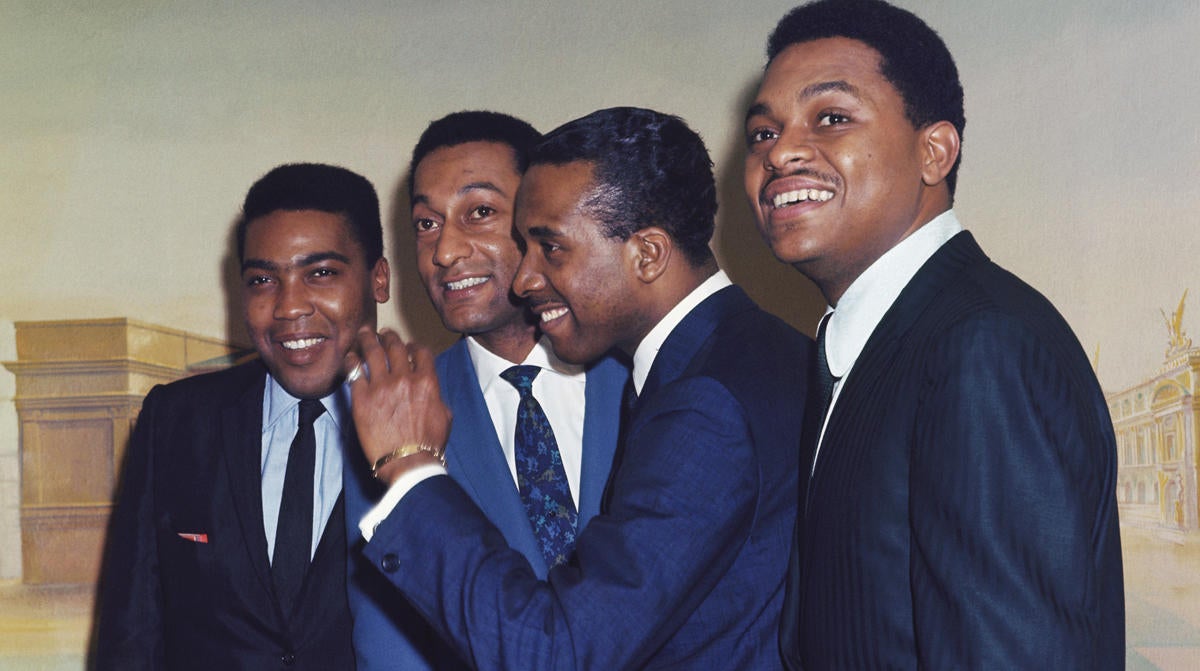Elizabeth Olsen Knows What She Wants to Do Next
Spoilers for Love & Death below.
Before she signed onto HBO Max’s miniseries Love & Death, Elizabeth Olsen didn’t know about Candy Montgomery, the Texan homemaker and churchgoer who, in 1980, brutally murdered her ex-lover’s wife Betty Gore with an axe. And even when she received the scripts from show creator David E. Kelley (Big Little Lies) and director Lesli Linka Glatter (Mad Men), she didn’t immediately realize that it was a true story.
Audiences, however, might already be familiar Candy’s true-crime tale, if for no reason other than Hulu’s recent show Candy, starring Jessica Biel as the titular character and Melanie Lynskey as Betty. In the version featuring Olsen, the cast includes Lili Rabe (Betty), Patrick Fugit (in the role of Candy’s husband Pat) and Jesse Plemons, playing Betty’s husband, Allan Gore, who had a nearly year-long affair with Candy prior to the murdering of his wife.
At the start of their endeavor, neither Olsen nor the showrunners thought the other project was in the works. “When we were discussing doing this, we were told by multiple people that it wasn’t happening,” recalls Olsen during a recent video interview with ELLE.com. “But while we were filming, we learned that it was happening. You don’t usually sign onto something knowing that someone’s doing the same thing, because you understand it’s going to be compared,” she continues. “At this point, you just have to make peace with it. I would hope that the audiences would get something different [from this] in an interesting way.”
Love & Death, which debuts its finale today, does grant Olsen her wish when it comes to offering audiences something new, thanks in large part to Olsen’s exquisitely crafted portrayal of a restless woman out of step with her community’s conservative demands. Below, Olsen discusses her approach to Candy, some of the more challenging scenes to film through the final episode and what she would like to tackle next in her career.
What kind of responsibility goes into portraying someone who committed a true crime in terms of both empathizing with her and leaving room for the audience to have their own take?
I don’t focus on [these] pressures while filming. It’s something you think about when you make a decision and then you have to trust the creative heads of a show: your writer and your director, and trust the scripts and focus on doing your job. It’s really the before element is when you are really considering the potential weight of whether or not something makes you feel uncomfortable. I think of this event and its outcome as a kind of anomaly, which keeps people interested. Nothing really makes sense to people, the act of the crime itself as well as the outcome of the trial. And analyzing something that doesn’t make sense to us in a story is a useful way of processing things that seem frustrating and confusing to us as people.
Your performance brilliantly captures both the public persona of Candy and the private Candy. We all have those two faces, but in Candy’s case, it’s amplified because she has a performative side.
There’s a lot of research that went into these characters, but the research is limited to basically a book [Evidence of Love by James Atkinson] and some articles. Within the book, there are direct comments from the people who were a part of that, whose lives are affected, as well as letters and things like that. Specifically with her letters when she was younger, you start to understand someone’s value system. And the performance of what it means to be a woman in this location at this time is something that I was really curious about. The performative nature of femininity and how you can use it in ways to get what you want in the world was something I was curious about exploring, as well as the value systems of the location and these people.
When you think about it, there’s a lot of amazing progressive thinking going on in the late seventies, and these people chose to build a community in Texas where they could ignore those progressive changes and hold onto this idea of the nuclear family that feels dated to the fifties. And you think about what that mindset is. And I do think Candy struggled with the fact that that was her world, [because] she also understood the modernity of the time.
I also think of her as someone incapable of being alone with her thoughts. That there’s always something; [she’s] someone who is so motivated by constant activity, constantly being involved in projects, building businesses. I interpreted her choice of listening to music a lot in her private time as her true inability to be alone with quiet thoughts. And the moment she is forced to have to reckon with those thoughts because of her actions is when I think you’re allowed to have a shift in the character that you see more clearly.
You and Jesse Plemons are in various intimate scenes, and I’m not just referring to sex scenes. The affair between Candy and Allan starts awkward and childlike. What went into building that together?
It was really nice because Jesse had suggested a thought really early on, which is relating their relationship to that of people in high school. And I think when he had mentioned that, everything kind of fell into place of the emotional intelligence of where they are with relationships and their own personal experiences. They all got married so young and had kids immediately. Their personal experiences are almost out of a high schooler. And I’m not saying that the only way you have growth is by having multiple partners until you’re in your thirties, but there was a limit to how they communicated with their own partners and their intimacy within their own houses. And so I think he started us off on a really nice pitch and tone, a good ground for us to then build on.
And regarding the scenes that involve sex, I assume that you had intimacy coordinators. What kind of value do you think they bring onto the set?
We did. I think honestly the best value is they tell you how to make things look more realistic. It’s really nice to have, it’s almost like having a dance coach for someone to say, “Oh, it actually would look more realistic if your leg shape was here.” I think that’s a really helpful tool to have someone else specifically knowing tricks. I mean, if you think about it, if you’re timing camera movement and [syncing that up] with action, there’s a lot of coordinating for everyone to be on the same page. Winging and improvising those moments doesn’t make something more cinematic. So I think it was just nice to have someone to build these movements and tell you how you can make it look better or sexier.
A fascinating thing to me about the show is its trajectory through three different genres. It starts off with a darkly comedic tone, goes into more thriller-esque territory, and then becomes a courtroom procedural. What did those shifts mean for you, in terms of calibrating your performance?
I think that was a challenge for all of us, to figure out how to [maintain] the heightened quirky elements of the beginning, the first act of the series. Because that was something that I know we all fell in love with—it adds to this veneer that we’re trying to show of this world and these people. And then [the later part], I didn’t think so much as a thriller, but this character that I’ve built dealing with the truth of these moments.
And what was fun to me is her disillusionment of really thinking that she can trick people and that the truth wouldn’t come out. And I think holding on to how she could try and trick people or herself was an element that I always like being able to teeter on. Someone having secrets and what that looks like from a performance standpoint and how trustworthy is our protagonist is something I enjoy playing. And so that middle area was more or less that.
And then she’s broken during the procedural element. Everything that someone is asking her to be is nothing that she connects to and she’s drugged for a lot of it and trying to keep her family together at home. And so I think that the last act was the hardest for us to figure out how to continue the tonal thread because it does change. And I think that is a challenge within performance and within the writing.
The disillusionment you mention, it comes back even in the very last episode when she’s saying she could just go back to the way things are and go shopping without people staring.
Yeah, I felt like those were the opportunities when we get to see that she’s kind of this dreaming child and she really seems like she was a dreaming child through her childhood and through the stories that she shares in this specific book that we used as a reference. So there is that element of her just being a dreamer who believes in magic versus the harsh facts and reality.
I absolutely love Audrey Fisher’s costuming work, and the evolution of Candy’s style goes hand in hand with that trajectory that we were talking about. The way she presents herself to the world changes. Does costuming help inform your performance as an actor?
What was really helpful is, instead of trying to replicate an image of the day she was arrested and what she looked like throughout all those court photos, we focused on the woman who presented herself in trial, and how she presented herself, and went backwards from there. Because we were telling a story about two years that led up to that day.
We knew that we had to get to this place of this woman who’s presenting as conservative and mousey and someone who would never have an affair. But really, we had to figure out then, “What does that mean for how she expressed herself before the trial?”
And so it was really fun to try and carve out those outfits, specifically certain outfits that we found kind of odd. Why did she wear that when she went in to deal with the police at the police station the first time? Why did she dress up so formally? And those choices that go into those details, we kind of loved and adored. They were really informative of her mindset, of what she was using to her advantage in order to basically get away with something or make it all go away.
The murder scene is so truthfully and harrowingly done. And I imagine it had to be choreographed in detail. What was that challenge like for you and Lily Rabe? What kind of toll did it take on you?
There are quite a few elements that made it challenging. We shot it over a couple days, the actual fighting aspect. But the whole sequence was three or four days. We were on stages for the interior and on location at a different time for the exterior. Lily being six months pregnant also made it challenging because I felt very protective of her safety and she felt very confident in how she was able to control her body, but I felt very protective of me not making a mistake towards her. And then we choreographed the entire sequence based on lacerations that were read in the trial. It’s also connected to Candy’s testimony. But we were considering how she received lacerations based on the medical examiner. And that brutal reality made it feel really terrible to shoot and choreograph and consider. It’s pretty morbidly disturbing.
And then in the last episode, you have to play someone who not only committed that crime, but relives the crime through retelling it in the court. So your performance is operating on various levels.
I was really just thinking about all of the given circumstances for the moment of the trial. One being that she’s been sedated, another being that her lawyer has been pushing her to become emotional, which is something that she’s resisting as much as possible until this scripted element where she does cry when he presents the acts. But until that time, it was about fighting against emotions. I really believe that the biggest given circumstances during that entire trial was her trying to not become a freak show. And she cares so much about how people perceive her and how she is received by the world that she didn’t want to be a weeping woman in trial, even if it benefited her, which I just find, and then maybe she did lean into it because she knew it’d benefit her, who knows. But that’s what I was really focusing on I guess in the trial sequence.
You’ve done some much since Martha Marcy May Marlene across both film and TV and all kinds of scopes. Where do you hope to gravitate towards next? How do you choose your projects?
What I’m gravitating towards right now is really filmmaker driven, it’s all just filmmaker driven.
When I read something, I know if I’m the right person for it. And even if someone thinks that I am, I sometimes disagree. And I think it benefits them when I say no, because I think they’ll find someone who’s going to do a better job. There’s an instinct, either you feel it when you’re reading something or you don’t. But I do think that right now I’m in a place of trying to make movies and the scale is on the smaller side, because those are usually the tones or the pieces that I’m most interested in. I keep trying to do a commercial comedy or something, but I just never find them as funny as the twisted weird things that are not as broad. I find those to just be funnier. I’m open to any of it right now. But I really do want to stick with film. I feel like there’s a big pendulum swinging back towards film.
Who is a director that you’d love to work with but haven’t had a chance yet?
Ruben Östlund. I saw Force Majeure when it came out. He’s so creative. And The Square, I love. There’s always some sort of moral dilemma that I find hilarious about how he tells a story. And I love the way he surprises his audiences.
This interview has been edited and condensed for clarity.
Tomris Laffly is a freelance film writer and critic based in New York. A member of the New York Film Critics Circle (NYFCC), she regularly contributes to Variety and RogerEbert.com, with bylines in Time Out New York, Filmmaker Magazine, The Playlist and Vulture, among other outlets. She has a special interest in the awards season, costume design and women in film, covers various film festivals throughout the year including New York Film Festival, Sundance and Telluride and tweets from @TomiLaffly.









